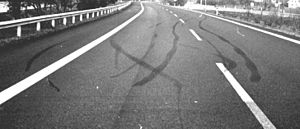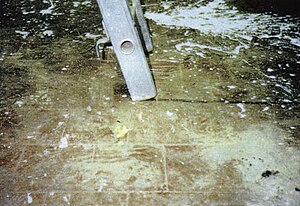Skid mark

In motoring terms, a skid mark is the mark a tire makes when a vehicle wheel stops rolling and slides or spins on the surface of the road. More generally, any solid which moves against another can cause visible marks, and is an important aspect of trace evidence analysis in forensic engineering.
Skid marks are divided in to "acceleration marks" created on acceleration, if the engine provides more power than the tire can transmit, "braking marks," if the brakes "lock up" and cause the tire to slide, or "yaw marks", if the tire slides sideways. Each has characteristic appearance, and an experienced accident reconstructor or forensic engineer can often determine what the vehicle was doing by examining the marks left by the tire.
In car accidents, skid marks are caused by rubber being deposited on the road, much like that of an eraser leaving pieces of rubber on a paper. Skid marks can also come about when a car suddenly accelerates on a slippery surface, or takes a hard corner. Skid marks are not made by temporary melting of the road surface,[citation needed] as can be shown by skid marks made on concrete by a bicycle, with children often having competitions about who can create the longest skid mark.[citation needed] The rubber of car tires heats up with sliding friction, degrades and disintegrates at the road-tire interface, and is deposited on the road surface.
Accident reconstruction
Such marks are important evidence for vehicular accident reconstruction, when their size and shape can reveal much about vehicle speed and forces of acceleration or deceleration. They are one form of trace evidence. They represent a form of contact evidence produced according to Locard's exchange principle. The length of the skid mark is usually closely related to the vehicle speed at the instant of braking, so measuring the marks yields an estimate of original speed.

Skid marks can also be formed where a ladder suddenly slips and the user falls to the ground, especially if the ladder feet are faulty or absent. Loss of the rubber feet or foot causes the aluminium stile to make contact with the ground, and if a hard surface like concrete or tiling, a skid mark shows how and why the ladder slipped. In the picture shown at right, the rubber foot in the stile end in the foreground had worn so severely that the remnants were pushed back into the hollow stile, so that it became redundant and allowed the ladder to slip, with catastrophic results for the user. The worn foot should have been replaced long before, and the employer had to pay damages to the injured painter. Ladder accidents are among the most common industrial and domestic accidents causing severe injuries both in the USA and the UK.
See also
- Forensic Science
- Forensic engineering
- Forensic materials engineering
- Forensic photography
- Forensic polymer engineering
- Polymer degradation
- Trace evidence
References
- Introduction to Forensic Engineering (The Forensic Library) by Randall K. Noon, CRC Press (1992).
- Forensic Engineering Investigation by Randall K. Noon, CRC Press (2000).
- Forensic Materials Engineering: Case Studies by Peter Rhys Lewis, Colin Gagg, Ken Reynolds, CRC Press (2004).
